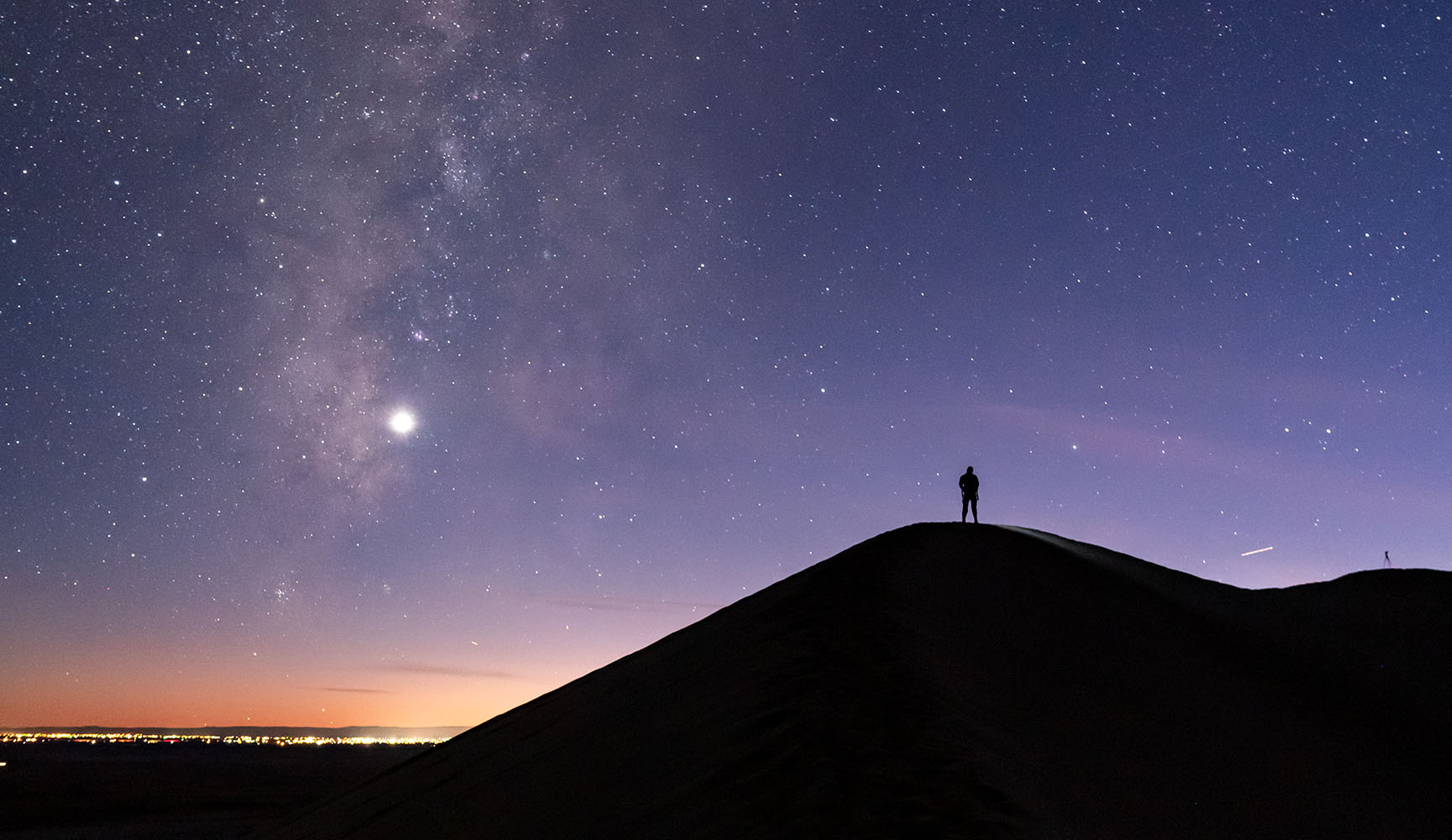It was a dark and starry night… So begins the novel PAUL CLIFFORD (written in 1830), by replacing ‘starry’ with ‘stormy,’ a much parodied opening line from the book, my first image of which was Snoopy sitting on his doghouse typing his great American Novel using those words on his typewriter. Mental images we take with our eyes, ‘cerebral photographs’ are part of the way we all view the world. What happens when we manipulate mental images with cameras such that what we see with our eyes is not what the camera sees? Let the artistic fun begin!
Imagine having the opportunity to drive a van transporting photographers for a workshop at the Great Sand Dunes National Park? Such was my honored task. This was not a normal day trip but an all nighter! The focus? Sunset, Milky Way, and the sunrise. The workshop participants had the opportunity to learn from the professionals at Tamron, a leading lens manufacturer, and the staff of National Park Trips Media. This was not their first National Park so Ken, Andre, Mark, and Damian have had time to perfect their craft of teaching about the technical aspects of nighttime photography, a lot more to it than aim and shoot! Technical terms like ISO, Aperture, shutter speed, lens’ sizes in millimeters, etc. were tossed around, all helping the students take the photos they were trying to digitally master. Wow! How fun, as I checked in on all the participants, peeking in on their camera screens, with permission of course, and looking at the shots they had taken moments before.
July 24/25th offered the monthly, 29.5 day cycle of the new moon phase where the sun’s light, from our perspective on Earth, does not illuminate any part of the moon visible to us. But, it gives the stars and planets a chance to shine brighter against a black sky as long as, according to Ken, we are away from dreaded big city lights. Fortunately, National Parks generally offer these darker skies, letting night photographers go to work!
July is also the summer monsoon season, when moisture flowing in from the Southwest can build in the sky creating monstrous thunderstorms, and douse the deserts and mountains with massive quantities of rain in a short period of time. But, the storms move on, skies clear and leave remnants of their work, the smells of desert sage, grasses and pine trees, wild looking but non-threatening clouds, and if the rain is heavy enough, cause flash flooding. Such as it was the night we were there. We were held up briefly by a ranger who told us that flash flooding across the road into the park had covered the road in mud. The plows did their work and soon we were at the Dune parking lot looking at the sunset, silhouettes of the darkening dunes, and high mountain ridge lines against a partly cloudy sky. Best let each of the pics below offer up the thousand words! Add to that the reflectivity of Medano Creek flowing across the wide expanse of its sandy bed and it was a sight for everyone, not just photographers!
The 21 participants set up their tripods on the sandy mountain beach, adjusted their cameras, lenses settings, and fired away at the sunset. Magic shots were taken as the four Tamron specialists dealt with questions, offered suggestions and took their own pics. I was trying to keep up with the technical jargon as I was armed only with my iPhone camera which becomes ineffective in darkness. We waited for clouds to dissipate and evaporate as the atmosphere settled. Soon, we waded across the cool waters and headed out into the Dunes. The Milky Way, our next quarry, the spiral galaxy of billions and billions of stars (had to throw that in for Carl Sagan), brightened in the blackened sky. Shutters captured, in many different ways, much more than we were seeing with our eyes.
Later came the light painting whereby, cameras were aimed at the sky as well as the ridgelines of the dunes. The sand was illuminated with flashlights and time exposures were increased in varying amounts such that the pictures taken would be creatively sharpened with softer or brighter images depending on length of exposure and the ‘light painter’s sand painting techniques.’
By one in the morning we were done. Back to the Hampton Inn for a 2 hour nap, and then back to the Dunes for Sunrise. This time, the class learned about depth of field while the sun came up, which torched the underbellies of clouds in orange and pinks, and shone on distant foothills and high mountains. More learning about lenses, polarizing filters, techniques, etc. and how they all work for the best in early morning photography.
Later, it was time to go back to the classroom, drink coffee, upload photos, and utilize one of many software programs to play artistically with photos. Andre’s software of choice was Adobe Lightroom. Much can be done to enhance photos from the field into a final version of what each photographer wants, which can be quite different for each of us. There is no such thing as a perfect photo because one person who may like a fuzzier background and clarity on part of the image, or a lighter foreground, versus another photographer who wants clean and crispy everything in his shots! Never knew there was so much that can be done to play with photos. I could carry on but truly, the many photos taken should be the stars of the blog. I did find two good quotes on quotegarden.com about photography:
“You don’t take a photograph. You ask quietly, to borrow it.” Author unknown
“Sometimes I get to places just when God’s ready to have somebody click the shutter.” Ansel Adams.
nationalparktripsmedia.com and tamron.com for upcoming photo workshops! Well worth a fun several days!





